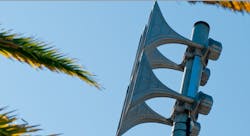Technology Outlook: Mass Notification on Campus
The use of mass notification systems (MNS) within the United States higher education market continues to increase and is being driven by several factors. According to a new IHS market research report, Market for Mass Notification Systems 2015, (http://technology.ihs.com/480342), MNS deployment in the total American higher education market — which includes North and South America — is expected to exceed $267 million by 2019.
Enrollment of new U.S. higher education students is expected to increase by more than 14 percent from 2014 through 2022. As enrollment rates continue to rise, universities are expected to invest in new facilities and retrofit existing facilities to meet current and future demands. MNS hardware is expected to see faster growth than MNS software over the next five years.
Higher education construction in the United States is forecast to grow by nearly 9 percent from 2014 to 2019. As a result, the MNS hardware market will increase by a compound annual growth rate (CAGR) of more than 8 percent during this time. Peripheral devices — such as UL-listed speakers, sounders, sirens, strobes and products with a combination of these features — will constitute the largest percentage of MNS hardware revenues in the higher education market. Unlike other hardware product types, such as giant voice, help points and voice modules, peripheral devices are mandated by U.S. fire codes and must be installed to meet regulatory requirements; therefore, peripherals growth closely tracks with construction growth in the U.S. higher education market.
Unlike the MNS hardware market, the MNS software market will increase at a CAGR of only 3 percent over the next five years. While an increase in student enrollment should result in more users of MNS software and increased revenue, price pressure in the U.S. higher education market has limited growth in the MNS software market — as the higher education market is very cost sensitive, typically paying less than $1.50 per user for distributed recipient communication solutions. For large universities that have 30,000 to 50,000 students and faculty, this cost sensitivity results in software supplier revenues of $45,000 to $75,000 per year.
Software solutions typically used by universities are capable of sending thousands of messages to users via SMS/text messaging, email, voice over Internet protocol (VoIP), cable TV, push notifications and other media. With public funding in decline, universities have been reluctant to raise tuition to pay for MNS software, which has resulted in fewer MNS software contracts and more competition for available contracts.
Despite slower growth in the MNS software market, opportunity remains as universities move to integrate their MNS. Integration of legacy MNS technologies for universities remains difficult, since many have multiple brands and various versions of equipment. Furthermore, many software suppliers have proprietary software that does not easily integrate with other MNS products, which creates limited opportunity for integrators who must work with multiple hardware manufacturers to provide seamless integration.
Universities continue to look for added value from MNS solutions, including the ability to use MNS software and hardware for non-emergency notification. Examples include notifying students of a parking issue due to an event on campus, or sending messages to digital displays to promote a university event. While MNS solutions continue to be purchased for emergency notifications, hardware manufacturers and software suppliers that can increase the use cases for their product — while providing seamless integration with other hardware and software —will find more opportunities within the higher education market.
Jared Bickenbach is an analyst for the IHS Security and Building Technology group.
